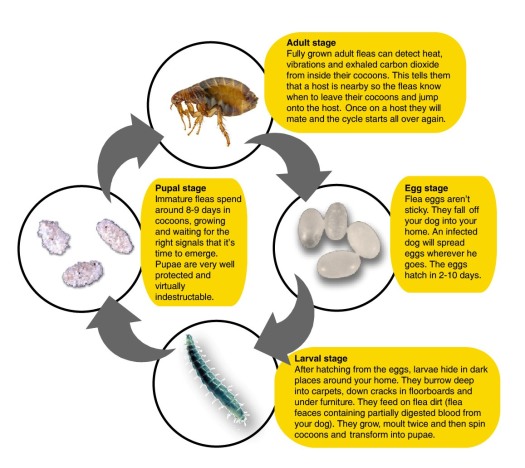I’ve lost count of how many times I’ve heard people say, “We’ve never had fleas,” then we find fleas or flea dirt during the physical exam.
Fleas are like cancer. They aren’t choosy, and we all know someone who has fought against them. And they are much harder to prevent than most people realize.
I have two indoor cats. They never go outside. But I apply Revolution every month, year-round. Because I know this from experience: the fleas will come inside to find them. Whether they hitch a ride on my jeans or shoes after smelling the cats on me, or they come in through cracks in window screens or under doors, I know they will always find a way. Life always finds a way.
Most people, if they use flea control, feel comfortable stopping it in the winter months. But they often stop way too early, like in August. It is recommended to wait until there are at least two good freezes to kill off the population outside. And as winter gets colder, they gravitate to warmth naturally, so their efforts to find shelter are redoubled. Then they set up business in your house. And sometimes, like this year, we have a mild winter.
Another mistake people make is waiting until they see fleas to use a flea control product. For every flea you see, there are thousands you won’t. Therefore, these products are given the appropriate name of “prevention.” But I like the term control better, because it is useful both to prevent an infestation, or to deal with one that is ongoing.
Because of the life cycle of the flea, continued control is needed to eradicate them. Development through the life cycle can take anywhere from a couple weeks to a few months. The higher the temperature and humidity in your house, the faster they multiply. And because you’re dealing with four levels of the life cycle, you can kill off one part of the population, but if you don’t continue treating periodically, the pupae and larvae will develop into adults and start boosting the population again.
There are eggs, larvae, pupae, and adults. One female flea can lay 40 eggs in 24 hours. And they are not eggs you can see. They often fall into the carpet or upholstery in your house. It can take anywhere between 2 days to 2 weeks for the eggs develop into hatching.
The larval stage usually lasts 5-20 days after hatching, then spins a cocoon to become pupae. These cocoons protect the developing flea for several days or weeks, depending on environmental conditions. If those conditions are not favorable, the pupae can remain in the cocoon for months, and in some cases, years.
The cocoons of the pupal stage are sticky enough to remain in the carpet fibers of your house despite light vacuuming, and can protect the occupant from chemicals. The adult flea won’t emerge until it senses vibration (such as people or pets walking around), carbon dioxide and body heat.
When the adult flea emerges from the cocoon, it needs to feed within a few hours. After the first blood meal, the fleas will breed. The female can start laying eggs as soon as a few days.

So the secret to flea control is PERSISTENCE. Adult fleas only account for 5% of the population in your home, so if you wait until you see them, it’s too late. The invasion is well underway. This is why treating the environment is just as, if not more important than, treating your pet.
- Vacuum frequently, being sure to seal and dispose of the vacuum bags or clean the canisters immediately. If you just vacuum and put the machine away, the adults will re-emerge.
- Wash your pets’ bedding and toys in hot water to kill any eggs, larvae and pupae hiding out.
- Use an area treatment, such as Siphotrol, both in your house and yard to control the flea population.
- Apply an effective flea product to every pet in the household every 28-30 days. The most effective and safest products can be recommended by your veterinarian, not the pet store employee. They mean well, but do not have the knowledge or experience your vet does.
- Some effective products include Nexgard, Comfortis, Trifexis, Frontline Gold, Advantage, and Revolution. Talk to your vet about what is best for your pet, as some products include heartworm prevention. And always be sure it is labeled for your pet’s species, age and weight.
- Be especially careful with chemicals and your cats. They are very sensitive to chemicals, and some do more harm than good. Never use a product for dogs on your cat.
Keep the product package after use in case side effects occur. You will want to have the instructions available, as well as contact information for the manufacturer.
- To report problems with spot-on flea or tick products, contact the National Pesticide Information Center (NPIC) at 1-800-858-7378.
- To report problems with FDA approved flea or tick drug products, contact the drug manufacturer directly (see contact information on product labeling) or report to FDA’s Center for Veterinary Medicine on a Form FDA 1932a.
- If your pet needs immediate medical care, call your local veterinarian, a local animal emergency clinic, or the National Animal Poison Control Center at 1-888-426-4435. The NAPCC charges a fee for consultation.*
What if you don’t do anything? Then you are playing Russian roulette with your pet’s health and well-being. Flea allergies exist, and can make both you and your pet miserable. No worthwhile flea and tick product for your pet will be inexpensive, but the cost far outweighs that of frequent vet visits and treatment of skin conditions, often involving steroids, which no vet wants to give your pet on a long-term basis. And the disease transmission is of concern also.
Trustworthy Resources:
The American Veterinary Medical Association https://www.avma.org/public/PetCare/Pages/Safe-use-of-flea-and-tick-preventive-products.aspx
PetMD.com http://www.petmd.com/flea-tick-survival-guide
* Taken from https://www.fda.gov/ForConsumers/ConsumerUpdates/ucm169831.htm
Helpful links:
Just because you find Frontline or Avantage at the store doesn’t mean it’s the real thing. https://www.avma.org/News/JAVMANews/Pages/040401b.aspx
A helpful article on some major ingredients and their pros/cons: https://www.vetinfo.com/compare-dog-flea-tick-treatment-products.html
